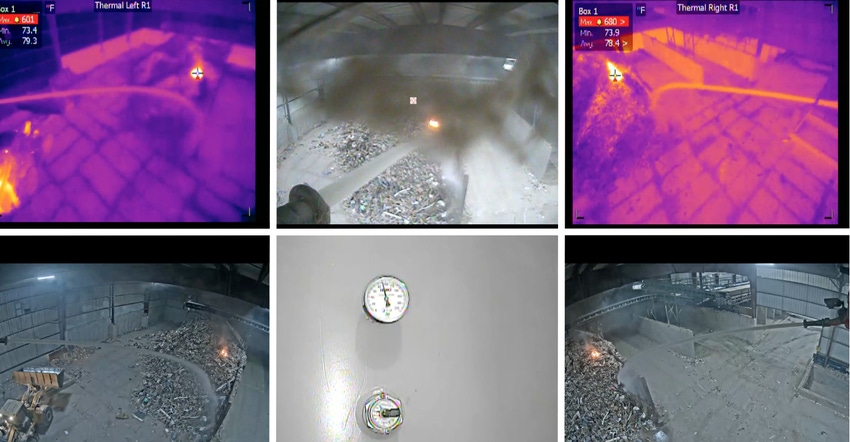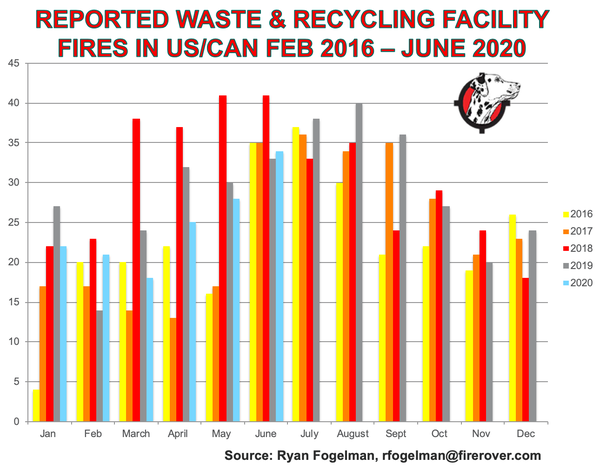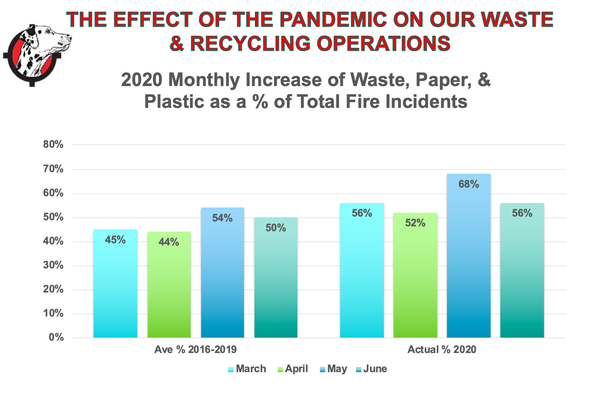
June is always a busy month for fires in waste and recycling facilities. June officially begins the “summertime spike” that we have been experiencing since I began tracking fire incidents in 2016.
This year is unique because June is not only the beginning of the summertime spike, but it is also the end to some stay-at-home orders initiated during the COVID-19 pandemic. In June, the industry incurred 34 reported fire incidents at our waste and recycling facilities. Similar to years past, scrap metal fire incidents have stayed at 35% of the total number of fire incidents for the month. But also in keeping with the trends we have been seeing due to the pandemic, solid waste fire incidents are up as a percent of the total number.

During the past 12 months, the waste and recycling industry has experienced 333 reported facility fires in the U.S. and Canada. Additionally, we incurred 40 reported injuries and five deaths that can either be directly or indirectly attributed to these fire incidents.
Based on reasonable assumptions, we can extrapolate that 1,800-plus facility fires have occurred during that time, which, based on the number of facilities reported by the Environmental Research & Education Foundation, is more than 40% of the industry. I define “reported facility fires” as any fire that has been reported by the media that occurs at a waste or recycling facility in the U.S. and Canada. Typically, the fires that are reported by the media are large fires that require fire professionals to arrive on scene and where there are effects that the public can witness.
How COVID-19 Is Affecting Our Current Waste and Recycling Streams
In each of the past four months, we have seen an increase in the number of waste, paper and plastic fire incidents at our facilities versus their monthly historical average. I believe we are experiencing this increase due to a number of factors, including the transition of tonnage to curbside from commercial after the stay-at-home orders went into effect.
We saw a significant uptick in consumer purchases that mimicked the holiday shopping season, but unlike a normal Q4, we had a large decrease in commercial activity. We also experienced the “100-year spring cleaning,” where households organized, discarded, donated and recycled like we have never seen before.

In June, we saw another stage of the pandemic as most of the country began to reopen. As this trend rolls into the historic summertime spike in fire incidents we have experienced, we need to continue to remain diligent — not just on our solid waste side of the business, as we typically see the number of scrap metal fires increase during the summer months.
In June, we experienced 12 reported fire incidents at our scrap metal, construction and demolition and electronics processing operations in the U.S. and Canada, which made up 35% of our monthly incidents. That was right in line when compared to the historical trend for the month of June from 2016 through 2019.
How Many Fires Did the Fire Rover Solution Eliminate?
Ever since I began sharing the reported waste and recycling facility fires with the public, I have been asked if I am able to share the incident data that our patented early detection and response solution has fought successfully. Although I will always keep our clients’ names confidential, I am proud to announce that in June, we successfully eliminated 17 fire incidents at our clients’ operations. We define an “elimination” as successfully detecting and responding to heat abnormality that needed response from the client, the local fire professionals or our Fire Rover solution to alleviate the problem.
It is true that some of these incidents are small, but there are a number of incidents that, without our early detection and response, would certainly have made the reported waste and recycling facility fire list published above.
For example, take a look at this incident video. Normal operating procedures combined with an unknown accelerant caused a large fire on our client's tip floor. Our remotely located Fire Rover Operator went into quick action, contacting local fire professionals and unloading more than 10,000 gallons of our environmentally friendly wetting agent onto the affected area. When the fire professionals arrived on the scene, they arrived to a smoke-filled but manageable situation where it was safe for them to finish the fight. Our client was back up and running the next day, processing the waste and recycling material that may have otherwise gone to a landfill.
Now that we have agreed on a solid definition internally, my team and I are keeping tight records that I plan to continue to share. Additionally, I plan to start adding this data to my analysis once we get enough data under our belt.
Fire Professional Injuries Down
Another positive this month was injuries incurred as a result of fire incidents. Fighting fires in the heat of the summer, wearing heavy equipment to protect our fire professionals from smoke and the heat from the flames doesn’t make for the safest conditions. Last year we saw a huge spike in fires which compromised 10 injuries across four incidents. We typically see more injuries during the summertime spike in fires that are related to heat that fire professionals are dealing with on top of the heat from the flames. (See this article from June 2019.) This month we only had two injuries across two incidents, which we can all hope is a trend that holds true for the rest of the summer.
Conclusion
We have officially made it to the second half of 2020. I think we can all agree that the first half of this year felt like an eternity. In next month’s article, I will spend some time analyzing the first half of this year. Have a safe July!
Ryan Fogelman, JD/MBA, is vice president of strategic partnerships for Fire Rover. He is focused on bringing innovative safety solutions to market, and two of his solutions have won the distinguished Edison Innovation Award for Industrial Safety and Consumer Products. He has been compiling and publishing the “The Reported Waste & Recycling Facility Fire In The US/CAN” since February 2016 and the “Waste & Recycling Facility Fire Annual Report.” Fogelman speaks regularly on the topic of the scope of fire problems facing the waste and recycling industries, detection solutions, proper fire planning and early-stage fire risk mitigation. Additionally, Fogelman is on the National Fire Protection Association’s Technical Committee for Hazard Materials.
About the Author(s)
You May Also Like




